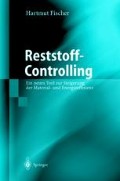Zusammenfassung
Die Industrie verwandelt einen erheblichen Anteil ihres stofflichen und energetischen Inputs nicht in das yom Kunden erwänschte Endprodukt, sondem in Abfall, Abwasser, Abluft und Abwärme. Bei weniger material- und energieintensiven Branchen wie Elektrogeräte oder Druckmaschinen liegt die Materialeffizienz 1 normalerweise bei 50–70 %. Bei Betrieben der Feinchemie mit mehrstufigen Syntheseprozessen kann sie durchaus auf 20–30 % sinken.
Access this chapter
Tax calculation will be finalised at checkout
Purchases are for personal use only
Preview
Unable to display preview. Download preview PDF.
Author information
Authors and Affiliations
Rights and permissions
Copyright information
© 2001 Springer-Verlag Berlin Heidelberg
About this chapter
Cite this chapter
Fischer, H. (2001). Einleitung. In: Reststoff-Controlling. Springer, Berlin, Heidelberg. https://doi.org/10.1007/978-3-642-56519-9_1
Download citation
DOI: https://doi.org/10.1007/978-3-642-56519-9_1
Publisher Name: Springer, Berlin, Heidelberg
Print ISBN: 978-3-642-62615-9
Online ISBN: 978-3-642-56519-9
eBook Packages: Springer Book Archive

